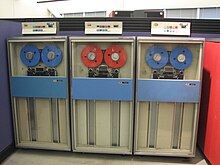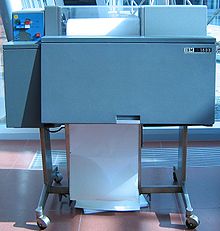The 2400 tape drives consisted of a combined drive and control unit, plus individual 1/2" tape drives attached. With the 360, IBM switched from IBM 7 track to9 track tape format. 2400 drives could be purchased that read and wrote 7 track tapes for compatibility with the older IBM 729 tape drives. In 1967, a slower and cheaper pair of tape drives with integrated control unit was introduced: the 2415. In 1968, the IBM 2420 tape system was released, offering much higher data rates, self-threading tape operation and 1600bpi packing density. It remained in the product line until 1979.
Unit record devices
- Punched card devices included the 2501 card reader and the 2540 card reader punch. Virtually every S/360 had a 2540. The 2560 MFCM ("Multi-Function Card Machine") reader/sorter/punch, listed above, was for the Model 20 only. It had notorious reliability problems (earning humorous acroymns often involving "...Card Muncher" or "Mal-Function Card Machine).
- Line printers were the IBM 1403 and the slower IBM 1443.
- A paper tape reader, the IBM 2671, was introduced in 1964. It had a rated speed of 1,000 cps. There were also a paper tape reader and paper tape punch from an earlier era, available only as RPQs (Request Price Quotation). The 1054 (reader) and 1055 (punch), which were carried forward (like the 1052 console typewriter) from the IBM 1050 Teleprocessing System. All these devices operated at a maximum of 15.5 characters per second. The paper tape punch from the IBM 1080 System was also available by RPQ, but at a prohibitively expensive price.
- Optical Character Recognition (OCR) devices 1287 and latter the 1288 were available on the 360's. The 1287 could read handwritten numerals, some OCR fonts, and cash register OCR paper tape reels. The 1288 'page reader' could handle up to legal size OCR font typewritten pages, as well as handwritten numerals. Both of these OCR devices employed a 'flying spot' scanning principle, with the raster scan provided by a large CRT, and the reflected light density changes were picked up by a high gain Photo Multiplier tube.
- MICR (Magnetic Ink Character Recognition) was provided by the IBM 1412 and 1419 Cheque Sorters, with Magnetic Ink Printing (for cheque books) on 1445 Printers (a modified 1443 that used an MICR ribbon). 1412/1419 and 1445 were mainly used by Banking Institutions.


0 comments:
Post a Comment